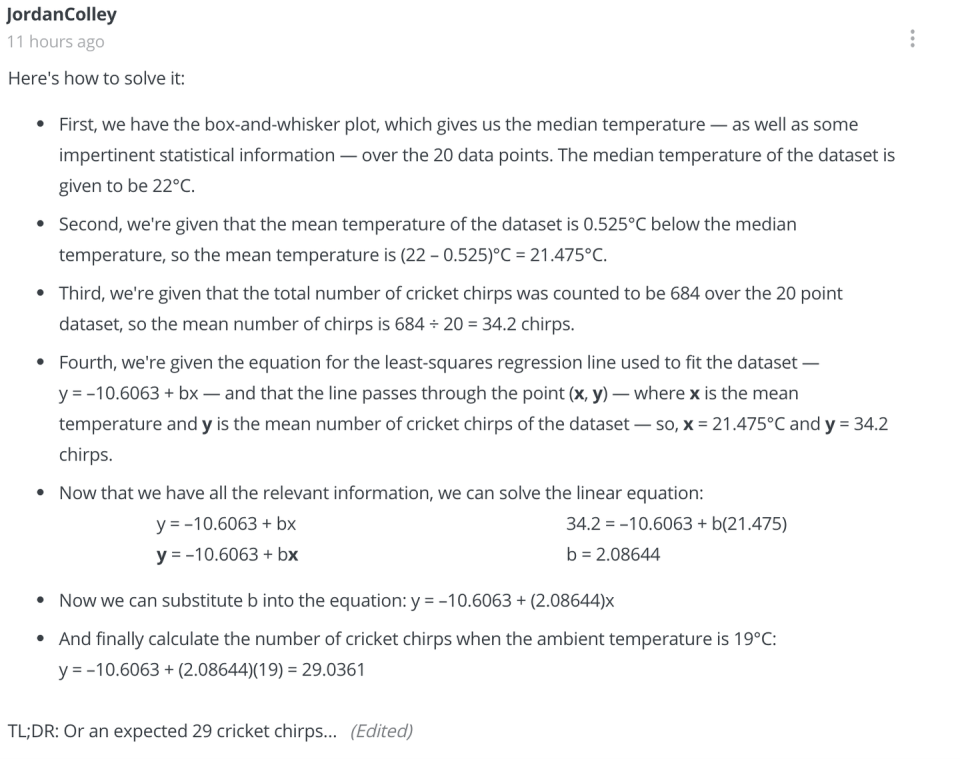This High School Math Problem Has the Internet Dumbfounded
"Regular" high school seniors in Australia faced an astonishing statistics problem in their exams.
Math is having a high profile year, from common core to Australia's high school exit exams.
The math problem is a crossover from the advanced exam and involves many steps.
Update 10/29: We've updated this story to include our readers' consensus solution to the problem.
An extremely confusing math problem has spread on social media, as extremely confusing math problems sometimes do.
➗ You love deep math. So do we. Let's nerd out over numbers together.
Our increased free time and frustration during quarantine seems to have led to increased scrutiny of the way math education is written—not the math itself, but the wording, nomenclature, and changing norms.
This problem, however, is the best of both worlds, written sparsely and representing advanced math for the group it’s testing. It’s about crickets, and it’s a doozy:

Australian news reports the New South Wales Education Standards Authority (NESA), which sets the Higher School Certificate (HSC)—the credential given to students who successfully complete senior high school level studies in that Australian state—insists the tricky math is part of the syllabus for students.
The HSC exams, like senior exams in many other countries, cover students’ knowledge across subject areas before determining they’re ready to graduate. This one has existed since the 1960s, but it was “refreshed” in 2019.
The issue arose after NESA changed the syllabus, News.com.au reports. “Under the changes, NESA included some of the same questions in both the standard and advanced maths courses. However, while students and teachers were expecting a handful of questions to be duplicated across both papers, in the end there were 23.”
i think my moots who did their maths hsc today will enjoy this 🙂🙂 pic.twitter.com/Cm2iaDns9w
— †sam⁷ (@HANDSOMETAEGI) October 26, 2020
anyways i tried to search this up and im going to cry why whatt does this meannd im breaking down why arre cricketsaksjfjf https://t.co/DoB1vREjJu pic.twitter.com/ZauKKHY14i
— amie ate ur liver (@ppuddlin) October 26, 2020
That means regular math students not studying an advanced curriculum, who thought they might see one or two moonshot questions from the advanced group, saw more than 20 of these problems.
The problem may look small and obtuse, but it’s really a series of complex steps that fold logically into each other—something that advanced students might be more familiar with, while regular math students may have no exposure to statistical analysis.
📚 The Best Math Books
The moonshot idea seems like the truth in this case. Students in general are set to expect tests they can master, and the HSC results have ranked outcomes that students must live with as they apply to university or other continuing education. But there’s another kind of exam, where the goal is to challenge students until their knowledge actually tops out.
The goal isn’t to judge them for missing a moonshot—it’s to get a realistic idea of where everyone is.
“The inclusion of common questions enables NESA to better understand student maths abilities across the different maths courses,” a spokesperson told News.com.au.
Is this pie-in-the-sky exam writing, or are they hoping to shake loose the next Good Will Hunting? Anyone waiting for a clear answer will be left with . . . crickets.
✏️ Editor's Update: The Readers Weigh In
After posting this story, we received a slew of reader responses to the problem, including on Facebook, via email, and in the comments below. Though we don't have an official answer from the NESA, we can now come to a reasonable consensus: 29 chirps.
While readers solved this problem in several creative ways, our favorite method comes from Jordan Colley. It checks out:

Thanks to Jordan and everyone else who volunteered their answers.
Disagree with Jordan and the other readers who came up with 29? Tell us why they're wrong. Continue to sound off in the comments below! ⬇
You Might Also Like

